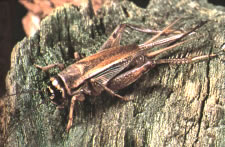Cricket caresheet

House Cricket (Acheta domesticus).
Crickets belong to the Order Orthoptera (which also includes the Grasshoppers) and have been kept in captivity for thousands of years as the singing of the adult males is considered pleasant by many people.
Housing
An aquarium with a tight fitting wooden lid makes a good cage, the lid is to prevent the crickets from jumping out, it needs to have ventilation holes and a fine wire mesh is ideal. Though they can be kept at room temperature (20°C), in colder climes they will be more active and sing better if given some warmth. An electric light or a heat pad are useful heat sources and around 30°C degrees is ideal for most species.
Most species of cricket seem happy with a regime of 16 hours of daylight to 8 hours of night including the primarily nocturnal Acheta domesticus. Most species need some sort of cover to hide in, egg cartons, the cardboard inner rolls from toilet rolls and inverted polystyrene cups all make suitable hideaways.
Feeding
All crickets are omnivorous and in the wild some species are carnivorous by choice. If crickets are not kept well fed they will prey on one another. A combination of rolled oats with fresh fruit and vegetables is a good diet. You should also removed any uneaten fruit before it goes mouldy.
Water
Water should be made available in a shallow bowl filled with cotton wool which should be changed as it gets dirty, alternately water can be supplied in mini inverted drinkers similar to those used for poultry.
Breeding
The females will lay their eggs in the damp cotton wool which should be changed twice a week. The old cotton wool should be placed in a well ventilated plastic box in a warm airing cupboard. The eggs should hatch in a week or two, depending on the temperature. The young and the adults can be kept together providing they have plenty of food.
Suggested species
- House Cricket (Acheta domesticus)
- Field Cricket (Gryllus bimaculatus)
Further information on Grasshoppers and Crickets.
Essential reading from the Amateur Entomologists' Society
Remember: it is important that you know the needs and requirements of your pet before you obtain the animal. You should never, ever obtain an animal before researching its needs and preparing the housing and conditions.

Want to know more?
If you want to know more about insects and other creepy-crawlies then join the AES today.
![Amateur Entomologists' Society home page [Logo]](/images/aes-logo-wplant.gif)